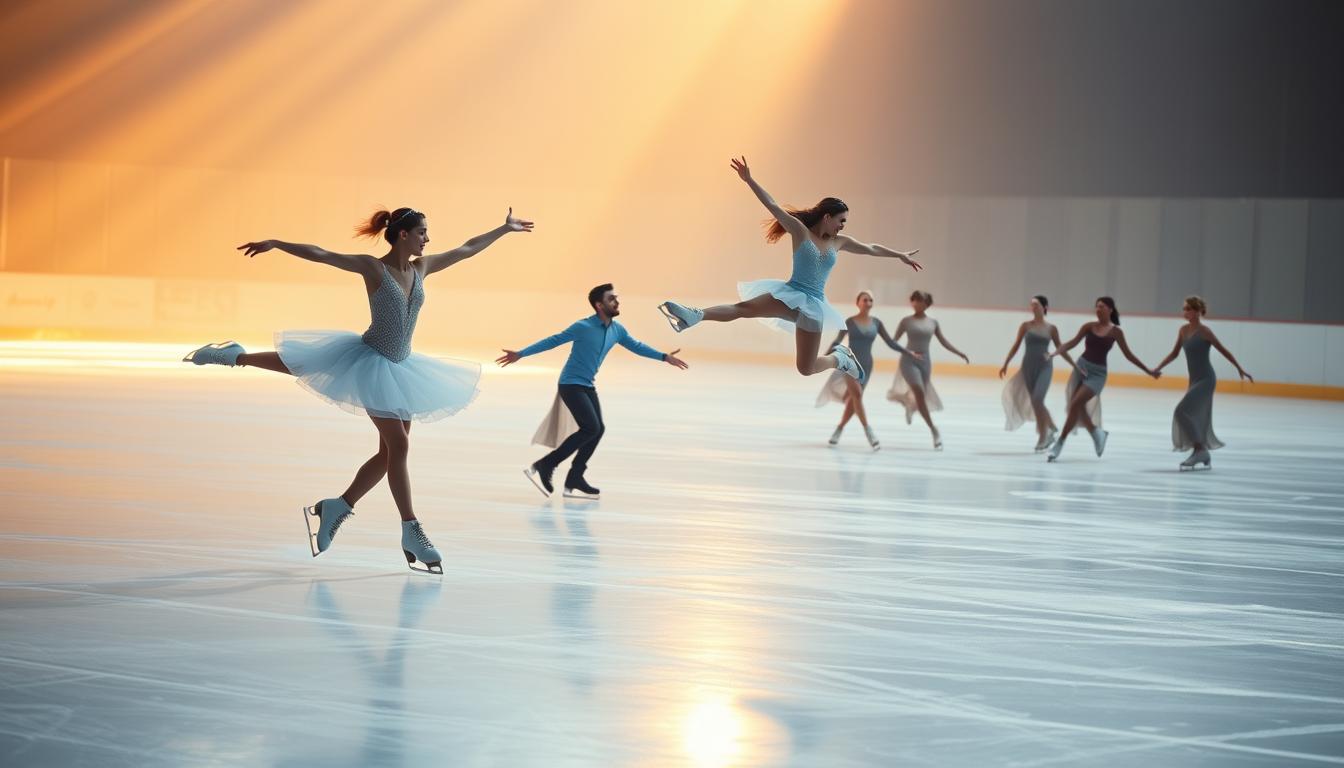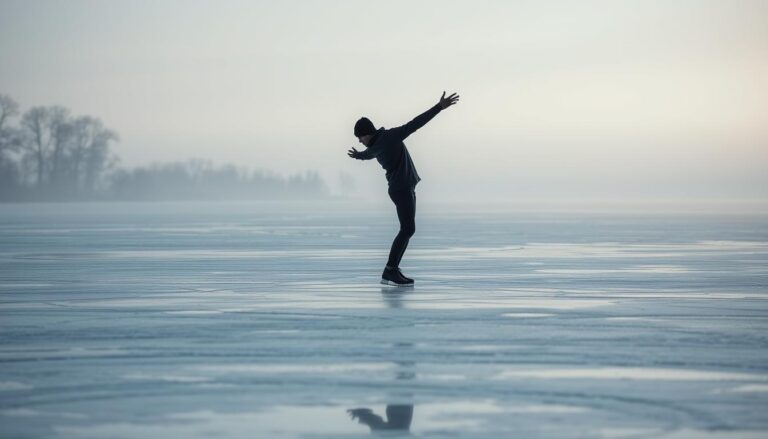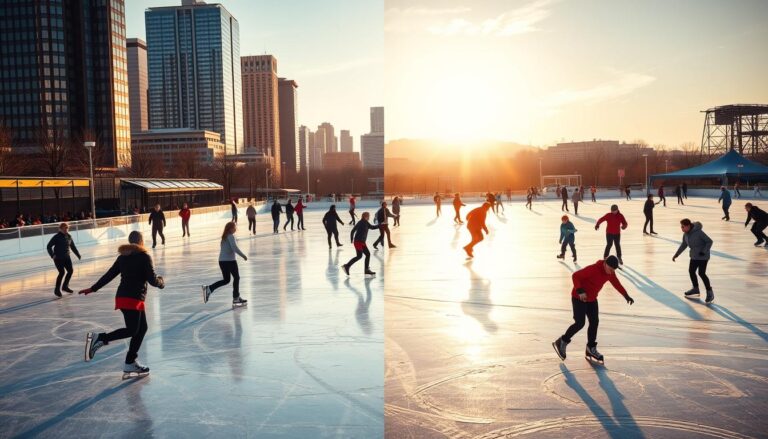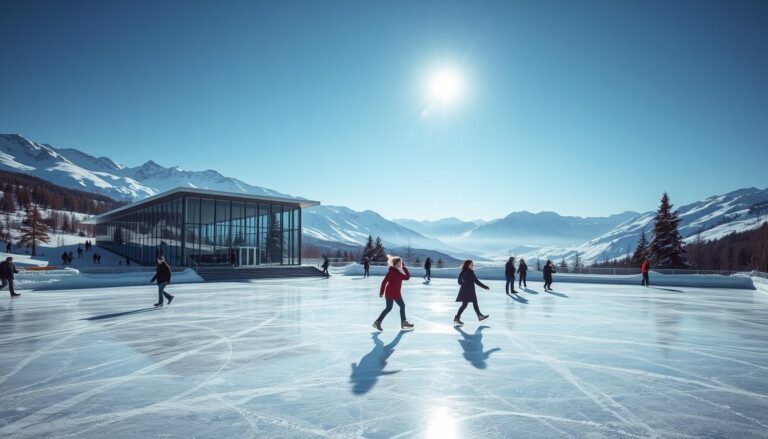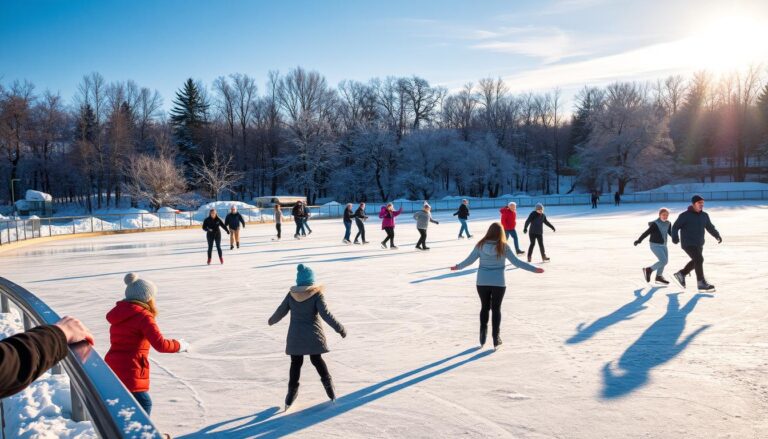Elevate Your Skating Game: Proven Techniques to Get Better
Imagine gliding across the ice with confidence. Your movements are smooth and precise. Learning to skate better isn’t just about talent—it’s about practice, technique, and passion.
Every world-class skater began where you are now. They were eager to improve and master the art of movement.
Skating is more than a sport. It’s a mix of athleticism, artistry, and personal expression. Whether you love figure skating’s elegance or hockey’s energy, improving takes dedication and the right approach.
The journey from beginner to skilled skater is about progress, not perfection. This guide will show you key techniques to improve balance, control, and technique.
Professional skaters know improving skills is a whole-body process. It’s not just about physical skills—mental preparation is key. Techniques like visualization and confidence-building can speed up your progress.
Your skating journey is special. Some progress fast, while others take more time. Both paths are valid. The key is to stay enthusiastic, practice regularly, and keep learning.
Every wobble and fall is a step towards mastery. As you explore this guide, be curious and patient. The best skaters didn’t have natural talent—they worked hard to develop it. Your skating journey begins now.
Essential Skating Equipment for Success
Starting to skate is more than just wanting to try it. The right gear makes all the difference. We’ll show you the must-haves for a great skating experience.
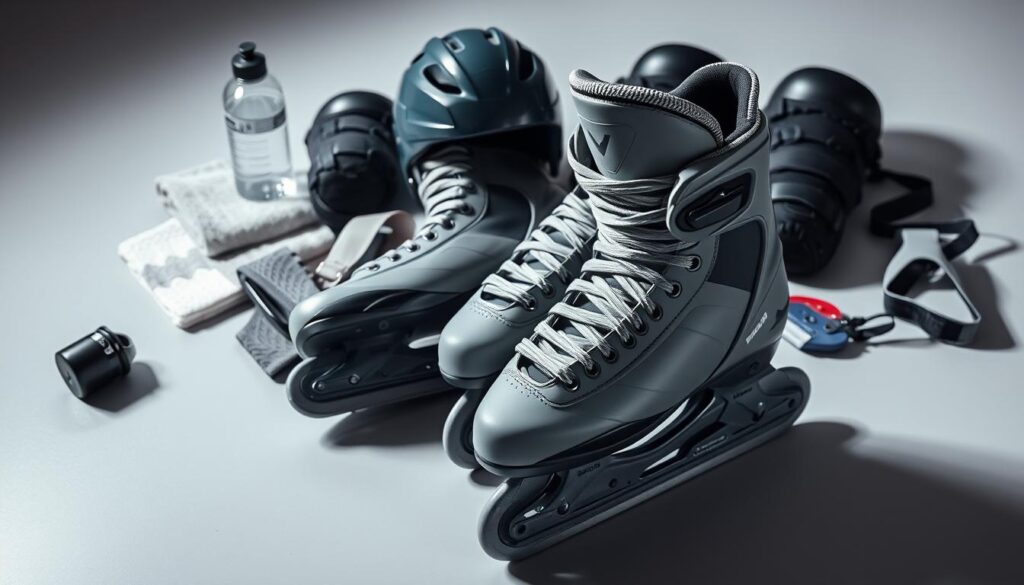
Choosing the right skating gear is key. It’s not just about looking good. It’s about performing well, staying safe, and feeling comfortable.
Choosing the Right Skates for Your Style
Finding the perfect skates is essential. Different skating styles need different gear:
- Figure Skates: Great for artistic moves and precise steps
- Inline Skates: Ideal for speed and outdoor skating
- Quad Skates: Best for roller derby and indoor skating
Protective Gear Essentials
Safety is always first. Your protective gear keeps you safe from injuries:
- Helmet (always protect your head!)
- Knee pads
- Elbow pads
- Wrist guards
Maintenance Tools and Supplies
Keeping your gear in good shape is important. A basic maintenance kit includes:
- Bearing cleaner
- Lubricant
- Wheel alignment tool
- Replacement parts
Pro skating tip: Regular care keeps your gear in top shape. The right gear is the key to skating success!
Understanding Skating Fundamentals
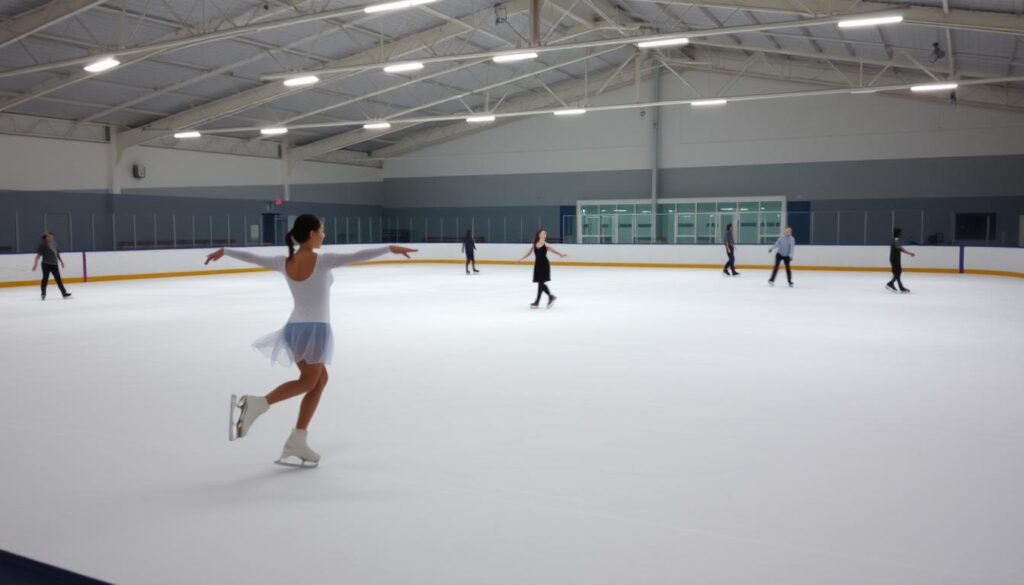
Learning to skate starts with the basics. You need to grasp balance, physics, and how your body moves. Skaters build their skills by focusing on a strong foundation.
Skating is a science that involves key elements. These help you get better at skating:
- Weight distribution and body alignment
- Understanding friction and momentum
- Developing muscle memory
- Recognizing center of gravity
Friction is very important in skating. It affects your speed, control, and balance. Skaters must learn to use friction to their advantage.
| Skating Fundamental | Key Skill Development | Practice Focus |
|---|---|---|
| Balance | Core strength | Stationary exercises |
| Weight Transfer | Leg muscle coordination | Dynamic movement drills |
| Body Alignment | Posture control | Alignment visualization |
Professional skaters work hard to master these basics. Your journey starts with understanding your body’s movements. With patience and practice, you’ll move smoothly and confidently.
How to Get Better at Skating: Core Techniques
Getting better at skating takes skill, practice, and the right basics. Whether you’re new or want to boost your skills, knowing the core techniques is key. It helps you move smoothly and confidently.
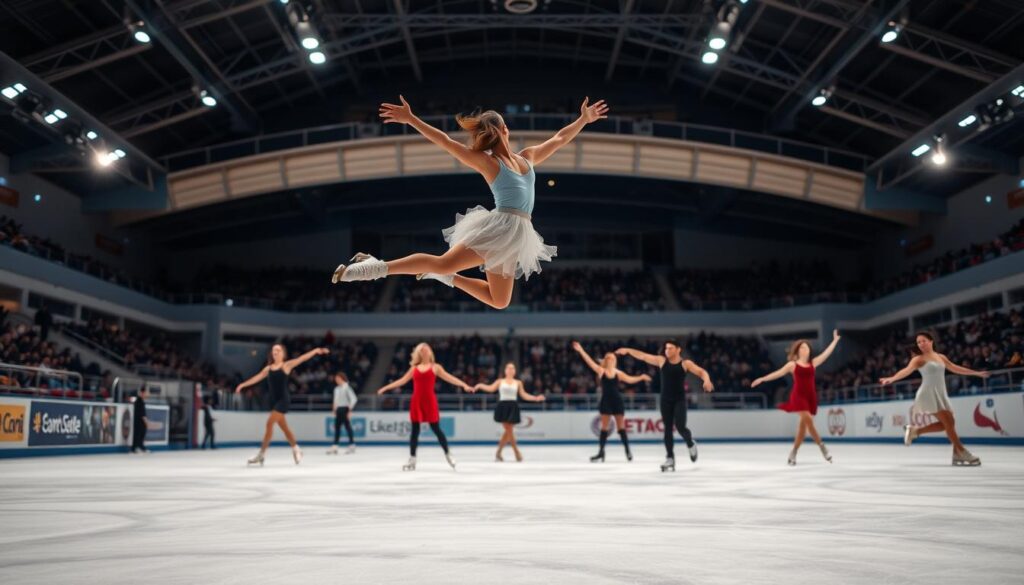
Starting to improve your skating begins with a solid foundation. The right steps can turn your skating from shaky to smooth in a few practice sessions.
Proper Stance and Balance
Your skating journey starts with mastering your stance. A good skating stance includes:
- Knees slightly bent for stability
- Weight centered over the middle of your skates
- Shoulders relaxed and aligned with your hips
- Head up and looking forward
Basic Movement Patterns
Smooth skating comes from knowing basic movements. Start with these key skills:
- Push and glide technique
- Weight transfer between legs
- Maintaining a consistent rhythm
- Controlling your speed and direction
Stopping Methods and Control
Learning to stop safely and confidently is vital. Skating techniques for stopping depend on your skill and style. Practice these main stopping methods:
- T-stop: Drag one foot perpendicular behind you
- Heel brake method for beginners
- Parallel stop for more advanced skaters
- Controlled glide to reduce speed
Remember, regular practice is essential for better skating. Each skill needs patience and repetition to master.
Building Strength and Flexibility for Skating
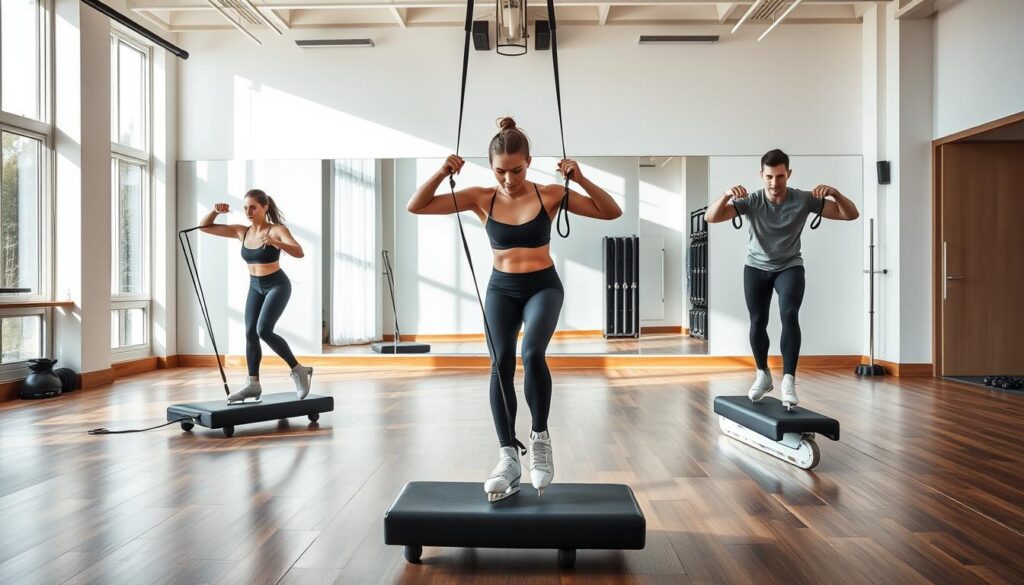
Getting strong is key for better skating. Skaters need more than just how to skate. They need to be in top shape to perform well.
Having a strong core is essential. Your core muscles help you stay stable and powerful. This is important for doing skating moves well.
- Strengthen your core with targeted exercises
- Develop leg muscles for powerful glides
- Enhance overall body flexibility
- Improve balance and coordination
Doing specific exercises can really help your skating. Squats, lunges, and planks are great for building the muscles you need to skate well.
Key Muscle Groups for Skaters
| Muscle Group | Importance for Skating | Recommended Exercises |
|---|---|---|
| Quadriceps | Power and Thrust | Weighted Squats |
| Core | Balance and Stability | Planks and Russian Twists |
| Glutes | Skating Propulsion | Glute Bridges |
Professional skaters know that training off the ice is just as important. Working on strength and flexibility helps you skate better and stay injury-free.
Be consistent. Do these exercises 3-4 times a week. You’ll see big improvements in your skating.
Mastering Basic Skating Movements
Learning to skate well takes time and practice. Whether you’re using inline or quad skates, knowing the basics is key. It helps you skate better and feel more confident.
Getting good at skating means lots of practice and the right drills. You need to work on muscle memory, balance, and controlling your body.
Forward and Backward Skating Fundamentals
Good forward and backward skating starts with how you stand. Important things include:
- Keeping your center of gravity low
- Having your knees slightly bent
- Spreading your weight evenly
- Making smooth, controlled pushes
Crossovers and Smooth Transitions
Crossovers help you turn smoothly. To get better, try these drills:
- Practice crossing one foot over the other
- Keep your balance when moving sideways
- Use your legs to build speed
Developing Edge Control
Being able to control your edges is important. Work on edge-specific skills by focusing on:
- Using your inside and outside edges
- Spreading your weight
- Being flexible in your ankles
- Gliding smoothly
Regular practice of these skills will make you a better skater. You’ll feel more confident on your skates.
Common Skating Mistakes to Avoid
Starting out in skating can be tough. Knowing common mistakes helps beginners learn faster and feel more confident. This guide will show you key errors that can slow you down.
Getting the basics right is key. Many new skaters face challenges with basic movements. These mistakes can affect your safety and how well you skate.
- Poor Posture: Skating with a stiff body prevents fluid movement and increases fall risks
- Incorrect Weight Distribution: Leaning too far forward or backward disrupts balance
- Rigid Knees: Keeping legs straight reduces stability and shock absorption
- Looking Down: Watching your feet instead of the path ahead limits spatial awareness
Skating tips show that how you position your body is very important. Beginners often get stiff, leading to awkward movements and less control. Try to keep a relaxed, slightly bent stance with your knees.
Every mistake is a chance to get better. With practice, you’ll turn mistakes into skills. Stay patient and keep practicing to overcome these common issues.
Every pro skater was once a beginner. Enjoy the learning and keep going on your skating path.
Advanced Skating Techniques and Tricks
Skating is more than basic moves. It’s about mastering advanced tricks to become a true expert. As you get better, you’ll learn exciting techniques that improve your skills and confidence.
To get better at skating, you need dedication and a desire to learn complex moves. The journey to advanced techniques involves focused practice and understanding your body’s mechanics.
Jump Progressions
Jumping is a key skill in advanced skating. Skaters can improve by following a step-by-step approach:
- Begin with basic two-foot jumps
- Move on to single-foot jumps
- Work on rotation techniques
- Improve height and landing skills
Spin Techniques
Spinning needs great balance and core strength. Learning various spin types can greatly improve your skating.
| Spin Type | Difficulty Level | Key Technique |
|---|---|---|
| Upright Spin | Beginner | Vertical body alignment |
| Camel Spin | Intermediate | Extended leg position |
| Layback Spin | Advanced | Arched back technique |
Advanced Footwork Patterns
Complex footwork turns skating into an art form. Skaters can create detailed patterns by:
- Practicing edge control
- Learning crossover variations
- Developing rhythm and flow
- Incorporating directional changes
Remember, mastering advanced tricks takes patience, consistent practice, and a willingness to push yourself. Each new skill brings you closer to skating greatness.
Creating an Effective Practice Routine
Creating a good skating practice routine is key for those who want to get better at skating. How you train can greatly affect your performance and growth.
A good routine should mix skill development, physical training, and mental prep. Skaters need a plan that covers all parts of their training.
- Create a consistent weekly schedule
- Set specific skill improvement goals
- Incorporate targeted skill drills
- Track your progress systematically
To make the most of your skating routine, break your sessions into main parts:
| Training Component | Duration | Focus Area |
|---|---|---|
| Warm-up | 15 minutes | Flexibility and mobility |
| Technical Skills | 30 minutes | Specific skating techniques |
| Endurance Training | 20 minutes | Cardiovascular conditioning |
| Cool-down | 10 minutes | Recovery and stretching |
Pro tip: Consistency is key in your skating practice routine. Aim to practice at least 3-4 times per week to see significant improvements in your skating skills.
Remember, your routine should be flexible and change as needed. Listen to your body and adjust your training. Stay motivated by setting achievable goals.
Mental Preparation and Visualization Techniques
Skating tips are not just about physical skills. Your mental approach can greatly improve your performance. Professional skaters know that mental preparation is key to success.
Having a strong mental game is essential to get better at skating. Your mind helps you overcome challenges and reach new heights.
Building Confidence on Skates
Confidence comes from knowing your skating journey. Every skater’s path is unique. Recognizing your progress helps build self-assurance.
- Set realistic, achievable goals
- Celebrate small victories
- Practice positive self-talk
- Visualize successful skating movements
Overcoming Fear and Mental Blocks
Fear can hold you back in skating. Psychological preparation helps skaters overcome mental barriers and build resilience.
- Identify specific fears (falling, specific moves)
- Use controlled exposure techniques
- Practice breathing and relaxation methods
- Seek support from experienced skaters
Professional skaters use visualization to mentally practice moves. By imagining successful performances, you build muscle memory and reduce anxiety.
Remember, skating is as much a mental sport as a physical one. Your mindset determines your ability to excel and enjoy skating.
Cross-Training Activities for Skaters
Getting better at skating is more than just ice time. Cross-training boosts your skills by strengthening your core, improving flexibility, and boosting athleticism. It helps skaters become better by adding training that matches their main sport.
Good cross-training builds key physical traits that help in skating. It can make you better at balance, power, and knowing your body.
- Yoga for flexibility and core strength
- Pilates to develop muscular control
- Strength training for explosive power
- Dance classes to improve rhythm and coordination
- Gymnastics for balance and body awareness
For better skating, focus on exercises that work many muscles at once. Dynamic movements that engage the entire body can greatly improve your skating.
| Cross-Training Activity | Key Benefits for Skating | Recommended Frequency |
|---|---|---|
| Strength Training | Leg power, core stability | 2-3 times per week |
| Yoga | Flexibility, balance | 1-2 times per week |
| Dance | Coordination, rhythm | 1-2 times per week |
Professional skaters know that mixing up their training keeps them improving and safe from injuries. By trying different activities, you build a strong athletic base that supports advanced skating.
Tracking Progress and Setting Goals
Mastering your skating routine is more than just showing up. Tracking your progress turns random practice into a strategic skill-building process. Skaters who set clear goals and measure their progress tend to improve faster and stay motivated.
Creating an effective tracking system helps you understand how to get better at skating. It provides tangible metrics and achievable milestones.
Measuring Skill Development
Skill development in skating involves multiple dimensions. Use these strategies to objectively measure your progress:
- Record video of your skating sessions to analyze technique
- Use a skill checklist to track specific movement patterns
- Time yourself performing specific skating maneuvers
- Document personal best achievements in speed and precision
Creating Achievement Milestones
Develop a structured approach to setting skating goals using the SMART framework:
- Specific: Define exact skills you want to improve
- Measurable: Establish clear performance indicators
- Achievable: Set realistic progression targets
- Relevant: Align goals with your skating style
- Time-bound: Create deadlines for skill mastery
By implementing these tracking methods, you’ll transform your skating practice into a systematic path of continuous improvement. Celebrate each milestone and stay committed to your skating development.
Safety Guidelines and Injury Prevention
Skating is fun, but safety comes first. As a beginner, knowing how to stay safe is key. It helps you enjoy skating more and avoid injuries.
Here are some important safety tips for beginners:
- Wear the right protective gear always
- Learn how to fall safely to avoid injuries
- Practice in safe, designated areas
- Always warm up before skating
Protective gear is vital for your safety. Your safety gear can be the difference between a minor mishap and a serious injury. Choose high-quality gear that fits well:
- Helmet (most important safety item)
- Wrist guards
- Knee pads
- Elbow pads
Knowing about common skating injuries can help you avoid them. Beginners often get:
- Wrist sprains
- Ankle twists
- Bruises from falls
- Muscle strains
To stay safe, work on your technique and balance. Take lessons from qualified instructors. They can give you tips and help you improve safely.
Conclusion
Learning to skate better is an exciting journey of growth and skill. This guide offers tips for all skaters, from beginners to experts. With practice, patience, and a challenge mindset, your skills will soar.
Every time you skate, you build muscle, confidence, and technique. It’s not about being perfect but making steady progress. Olympic skaters like Michelle Kwan grew with each practice session.
Skating is more than a sport; it’s a way to express yourself and show off your skills. Whether you skate on ice, wheels, or blades, the basics are the same. Stay curious, keep learning, and don’t shy away from new challenges.
Your skating journey is special. Record your progress, celebrate small wins, and aim for new skills. The rink is your playground, and your abilities are endless. So, grab your skates, trust your training, and enjoy every moment!
